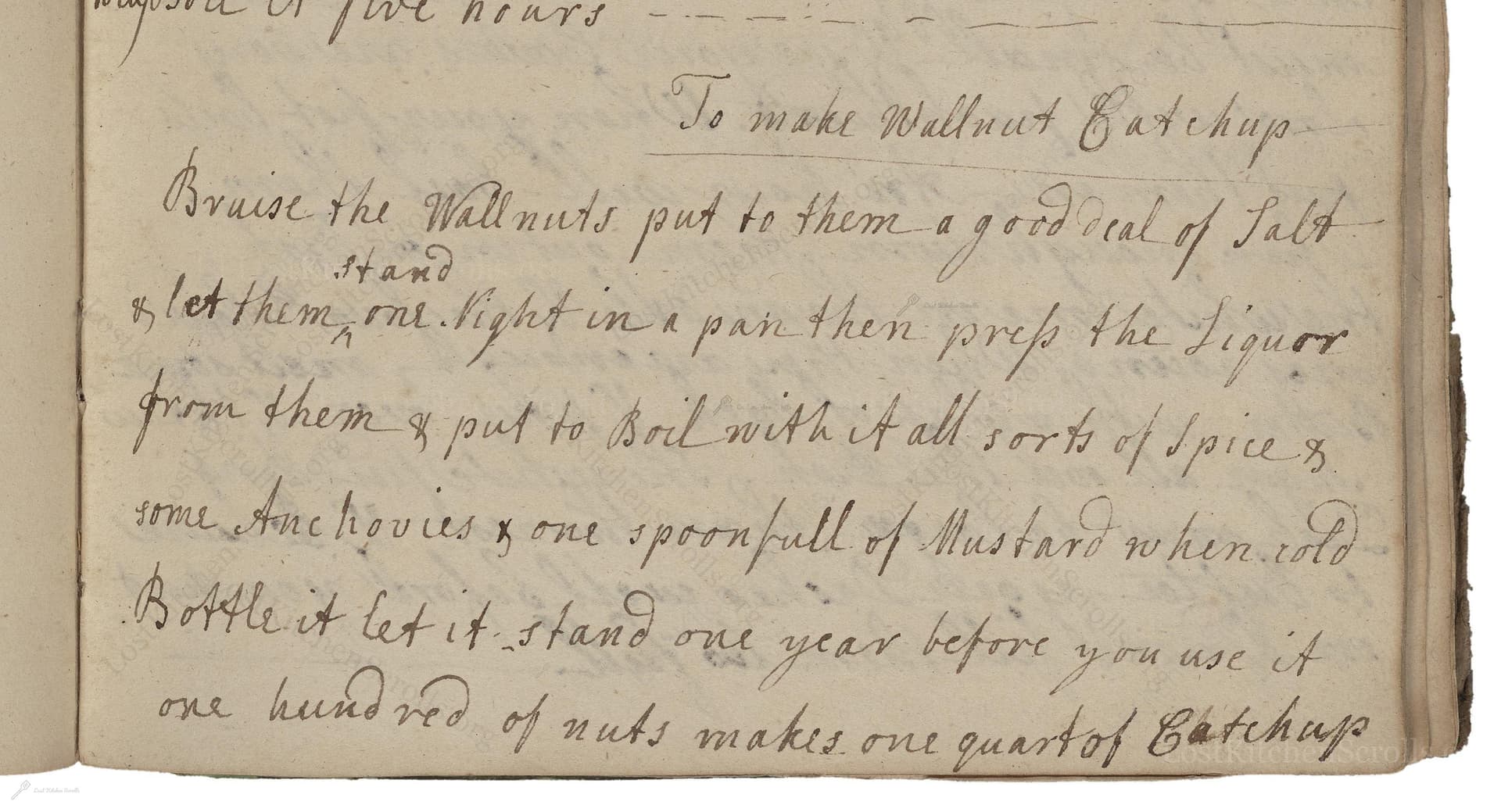To Make Wallnut Catchup
From the treasured pages of Cookery book of Jane Webb, compiled by several people
Written by Jane Webb

To Make Wallnut Catchup
"Bruise the Wallnuts put to them a good deal of Salt & let them stand one Night in a pan then press the liquor from them & put to boil with it all sorts of Spice & some Anchovies & one spoonfull of Mustard when cold Bottle it let it stand one year before you use it one hundred of nuts makes one quart of Catchup"
Note on the Original Text
Previously, recipes were written as continuous instructions rather than with precise steps or quantities as we expect today—the assumption was an experienced cook would fill in the blanks. Spelling, punctuation, and capitalizations were fluid ('Wallnut Catchup,' for instance), and measurements were either absent or estimated ('a good deal of Salt'). The recipe expects the cook to know the appropriate spices and method for bottling. The style is brief and focused on the essentials, reflecting both the capabilities and constraints of eighteenth-century kitchens, where improvisation was a valued skill.

Title
Cookery book of Jane Webb, compiled by several people (1738)
You can also click the book image above to peruse the original tome
Writer
Jane Webb
Era
1738
Publisher
Unknown
Background
A delightful glimpse into the culinary world of early 18th-century England, this manuscript offers a playful array of recipes and kitchen wisdom, reflecting the tastes and ingenuity of its era.
Kindly made available by
Folger Shakespeare Library
This recipe comes from Jane Webb's household manuscript, dated around 1725–1750, a period when English cookery was rich in preserving and flavoring techniques. Walnut ketchup, a dark, savory condiment, was a staple in Georgian kitchens and can be seen as a precursor to Worcestershire sauce. Unlike the tomato-based ketchup known today, these early ketchups took inspiration from Asian fermented sauces and incorporated nuts, mushrooms, or shellfish to add umami depth to meats and stews. In the eighteenth century, recipes such as this would showcase a cook’s skill at extractive cooking and preservation, crucial in a time with limited refrigeration. Ketchup matured in the bottle, developing a savory complexity prized at the dining tables of Georgian England.

Historically, cooks would bruise the walnuts using a large mortar and pestle or with a mallet on a board, then leave them to macerate in salt in ceramic or wooden pans. Once ready, the mixture would be pressed—often through a cloth or with a heavy press—to extract the flavorful liquid. Boiling was done over an open hearth in a heavy saucepan or kettle, and the resulting ketchup was strained through linen or muslin before bottling in stoneware or glass bottles, sealed with corks and wax.
Prep Time
30 mins
Cook Time
20 mins
Servings
16
We've done our best to adapt this historical recipe for modern kitchens, but some details may still need refinement. We warmly welcome feedback from fellow cooks and culinary historians — your insights support the entire community!
Ingredients
- 100 young green walnuts (~3 1/3 lbs)
- 2 1/2 oz fine sea salt
- 1 tbsp prepared mustard
- 4 anchovy fillets (or 1 heaped tsp anchovy paste)
- 1 tsp black peppercorns
- 1 tsp allspice berries
- 1 tsp whole cloves
- 1 blade mace
- 1 small piece fresh ginger (about 1/3 oz, sliced)
Instructions
- To make walnut ketchup using modern methods, take about 100 young green walnuts (approximately 3 1/3 lbs) and bruise or crush them well—using a food processor or a heavy pestle—then mix with a generous amount of salt, roughly 2 1/2 oz.
- Let this mixture rest overnight in a large bowl or non-reactive pan.
- The next day, press the mixture through a fine sieve or use cheesecloth to extract as much liquid as possible.
- Transfer the extracted juice to a saucepan and add a spoonful (1 tbsp) of prepared mustard, 4 anchovy fillets, and a mixture of whole spices—such as 1 tsp each of black peppercorns, allspice berries, and cloves, plus a blade of mace and a small piece of ginger.
- Bring the mixture to a boil, then simmer gently for about 15–20 minutes.
- Let the liquid cool, strain out the solids, and bottle the ketchup in sterilized bottles or jars.
- Seal tightly.
- For authenticity, age the ketchup for at least one year in a cool, dark place before using—it will keep developing its deep, savory flavor.
Estimated Calories
15 per serving
Cooking Estimates
You’ll need a few minutes to bruise the walnuts and mix them with salt, then the mixture rests overnight. Cooking only takes about 20 minutes. This recipe makes about one 500 ml bottle, which is about 16 servings. Each serving is very low in calories, since you use only a small amount each time.
As noted above, we have made our best effort to translate and adapt this historical recipe for modern kitchens, taking into account ingredients nowadays, cooking techniques, measurements, and so on. However, historical recipes often contain assumptions that require interpretation.
We'd love for anyone to help improve these adaptations. Community contributions are highly welcome. If you have suggestions, corrections, or cooking tips based on your experience with this recipe, please share them below.
Join the Discussion
Rate This Recipe
Dietary Preference
Main Ingredients
Culinary Technique
Occasions

Den Bockfisch In Einer Fleisch Suppen Zu Kochen
This recipe hails from a German manuscript cookbook compiled in 1696, a time whe...

Die Grieß Nudlen Zumachen
This recipe comes from a rather mysterious manuscript cookbook, penned anonymous...

Ein Boudain
This recipe comes from an anonymous German-language manuscript cookbook from 169...

Ein Gesaltzen Citroni
This recipe, dating from 1696, comes from an extensive anonymous German cookbook...
Browse our complete collection of time-honored recipes



